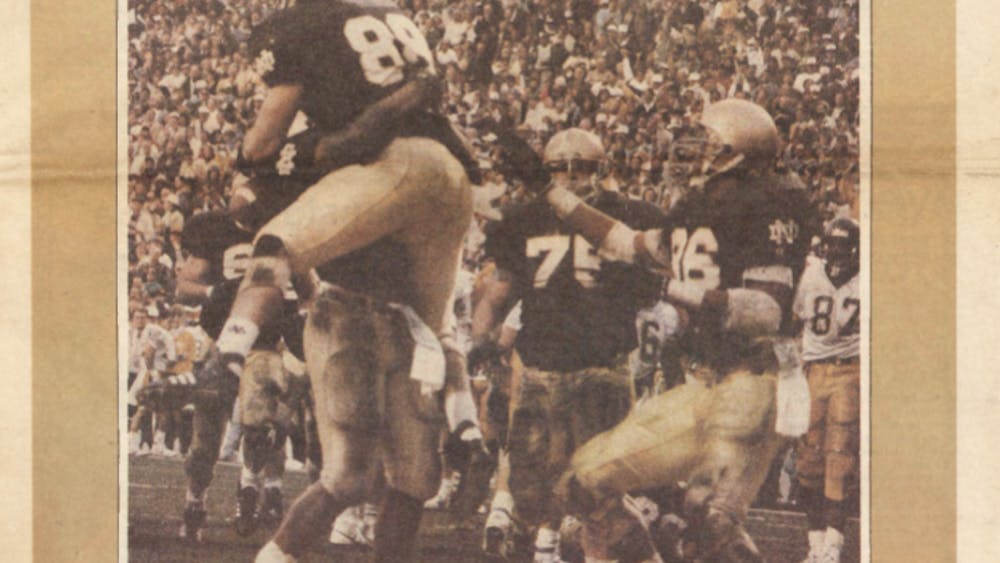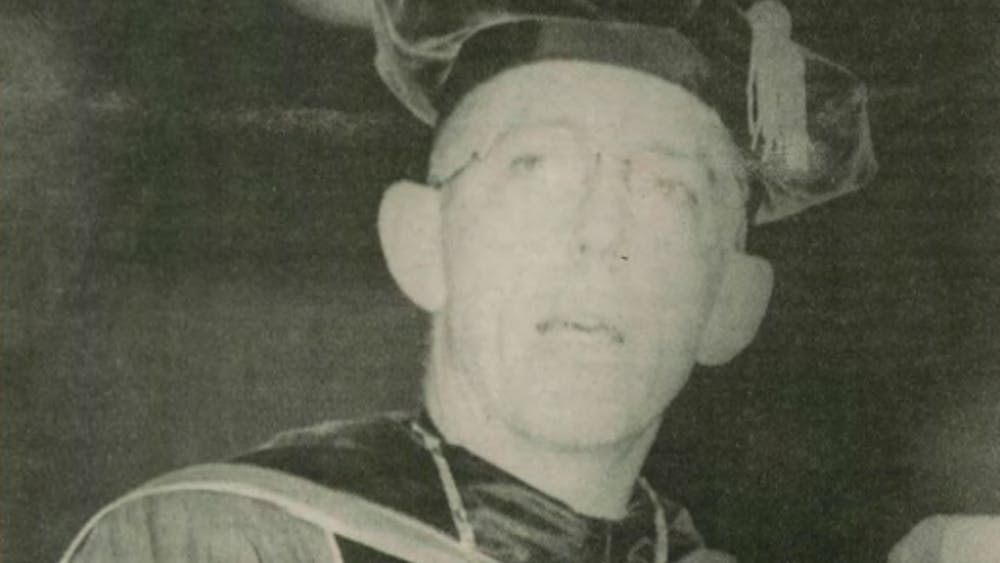In our edition celebrating 50 years of women at Notre Dame, we highlighted the often contentious nature of the coeducation process in the early 1970s. One aspect we couldn’t cover in detail was the decision over which of the men’s dorms would be converted to accommodate the new female students — a ruling arguably more controversial than the decision to go coed itself.
This week, From the Archives details the spirited saga that commenced when Badin and Walsh were selected as the first female dorms at Notre Dame. Residents of these halls were naturally displeased with the decision, conjuring up creative and even self deprecatory arguments for why the administration should reconsider. But eventually, the inevitable changes brought by co-education arrived at a reckoning, presenting enduring lessons for how to deal with change at a university steeped in history and tradition.
Badin and Walsh revealed as the first female dorms
Feb. 9 1972 | Maria Gallagher | Feb. 11 1972 | Ann McCarry | Researched by Thomas Dobbs
On Feb. 8, 1972, vice president of student affairs Rev. Thomas Blantz designated Badin and Walsh as the first residences for female undergraduates at Notre Dame for the 1972-1973 academic year.
According to Rev. Blantz, Badin and Walsh were selected as they offered “appropriate security for young women … adequate physical facilities … and room available for social and recreational activities.”
This explanation did not suffice for many displaced Badin and Walsh residents who expressed “confusion” and “disappointment” with the decision. Badin Hall President Buz Imhoff ‘72 called the decision a “most illogical choice.”

In an attempt to persuade university leaders to reconsider their decision, Badin residents presented a two-sided defense of their hall. On one hand, Badin resident and Hall Life Commissioner Bob Higgins (‘73) argued that Badin’s spirit was “excellent” and was “the only thing that keeps guys wanting to live there.”
Imhoff contributed some decidedly self-deprecatory arguments, claiming that Badin offered inadequate “lounge space” and overall “dismal” conditions that would forbid female inhabitance. The focus on Badin’s spacial shortcomings led to the crux of Higgins’s proposal: “Girls should be offered at least livable conditions” and that current Badin Hall residents could sacrifice by remaining in apparent “unlivable” conditions.
In a Feb. 10 address in the Howard Hall chapel to approximately 100 Walsh and Badin residents, University President Fr. Theodore Hesburgh urged students that “if you want the value of girls on campus, you have to have static … no matter what halls you choose.”

Although displacement was not a welcome move for Badin residents, Badin Hall Council appeared satisfied with Fr. Hesburgh’s argument, announcing that they “realize that some hall must be chosen for the purpose of female housing.”
Badin Hall Council, however, did offer some suggestions for the University, requesting that they be allowed to preserve their sections in moves to other halls and that they not be displaced again “in the spirit of fairness.” In his original announcement, Fr. Blantz had outlined the displacement procedure, in which approximately 330 students Badin and Walsh Student were to be distributed among the other 18 residence halls based on “its ability to absorb upperclass transfers.”
In apparent recognition of the concerns of Badin Hall about further displacement, Fr. Hesburgh reminded students that he expected to follow the same procedure in the coming years as female enrollment expanded and other dorms were converted for female use.
Thoughts on the Badin and Walsh transition
Feb. 14, 1972 | Marlene Zloza | Feb. 16, 1972 | Jerry Lutkus | Feb. 17, 1972 | Letter to Editor | May 4, 1972 | Observer Staff | Researched by Cade Czarnecki
While the Badin Hall Council accepted the University’s decision to turn their dorm into a female residence, the early months of 1972 saw significant pushback from many residents of Badin and Walsh and from other members of the tri-campus community.
The men that were being forced out of Badin and Walsh were told by the University and housing committee that, “since we wanted the women, we should be prepared to make the sacrifices necessary to house them on campus.”
Badin and Walsh residents countered with the rationale that the burden should be shared across all dorms on campus, pointing out the fact that it was not exclusively Badin and Walsh men that wanted women at Notre Dame.

Counter proposals were offered to the “ad hoc housing committee” that was formed to sort out the relocation of Badin and Walsh men. One proposal to the committee was to have each hall on campus allocate 10 to 15 beds in a section together for “blocks” of exiled Badin and Walsh residents to move to.
Pushback to the removal of men and implementation of women in Badin and Walsh did not exclusively come from males, though. Marlene Zloza, a Saint Mary’s freshman, toured both Badin and Walsh, and her report on the state of the dorms was mixed.
Zloza highlighted the amenities in Walsh and, in doing so, pointed out the various flaws in Badin. Complaints included minimal lounge space and the presence of metal closets in the hallways. She continued to say that there was no real space for a kitchen or laundry room in Badin either.
After highlighting the bats that called Walsh home and the friendly neighborhood mice in Badin, Zloza concluded that women would not want to live in Badin and would be better housed in Walsh.

Yet, these opinions had little sway over the whole situation. Men were to be forced out and women were to be forced in.
In a solemn display in their final days in the building they had called home, Badin men hung a black wreath outside their dorm, signifying the death of their beloved residence hall.
The ghosts of coed integration at Notre Dame
Sept. 2, 1972 | Jerry Lutkus | Sept. 8, 1972 | Jerry Lutkus | Researched by Avery Polking
When women were first admitted to Notre Dame in 1972, they were welcomed by most of the campus community. But some male students lamented the profound changes that coeducation entailed, changes perhaps embodied best in the conversion of Badin and Walsh to female dorms.

A common refrain among Notre Dame men was feeling a loss of tradition over the introduction of women. Many felt like coeducation subverted an integral part of Notre Dame’s identity. But the author of “The Ghost of Badin” argued for a more progressive view of this monumental announcement.
Jerry Lutkus wrote that the nature of the real world must take precedent over tradition. Even though tradition is a “quantity around which legends are based,” tradition is notoriously bad at locating points of issue it creates because of its longevity and form. Neglecting to educate women, Lutkus wrote, is one of these points of issue.
Therefore, integrating women into Notre Dame, according to its proponents, was an act that brought Notre Dame into the real world. After all, “women and men are equals in society, why should they not be equal in education? At Notre Dame?”

Lutkus concluded by admitting that the “ghosts of tradition” left by men of Badin Hall no longer resided within its walls. This, however, was not a bad thing. The departure of old ghosts made way for new traditions created by the new female undergraduates who would call Badin home.
“So, that tradition that you think is destroyed at Notre Dame is actually not destroyed,” Lutkus wrote. “It is simply enhanced, expanded. It is added to and given a dimension it’s never seen before.”
Still seeping in tradition, Lutkus’ message to Notre Dame remains as salient as ever. While we can and should continue to honor the legacy of this historic University, many students and administrators today believe tradition should never preclude Notre Dame from evolving and improving to create a more inclusive campus environment.
As Lutkus put it fifty years ago, when we update our traditions, practices, and policies, “Notre Dame hasn’t become just any other college because it is still Notre Dame. But it is a new Notre Dame. A new Notre Dame with some new tradition added to the old and some openings for compatriots to keep company with the ghosts of ages past.”
Contact Spencer Kelly at skelly25@nd.edu
Thomas Dobbs at tdobbs@nd.edu
Cade Czarnecki at cczarne3@nd.edu
Avery Polking at apolking@nd.edu









